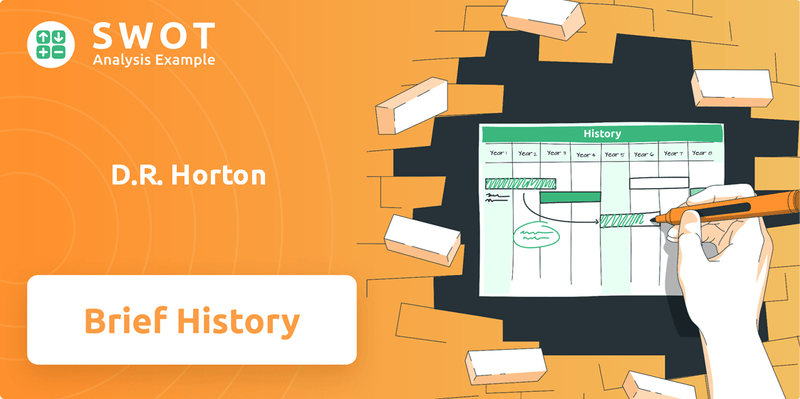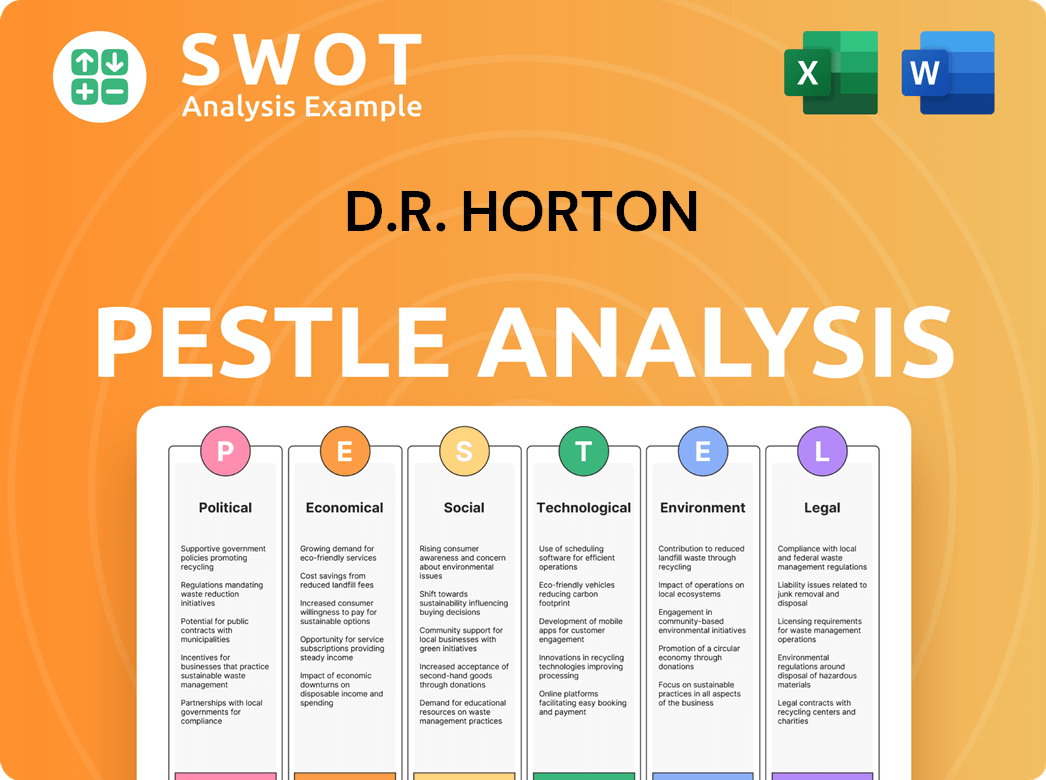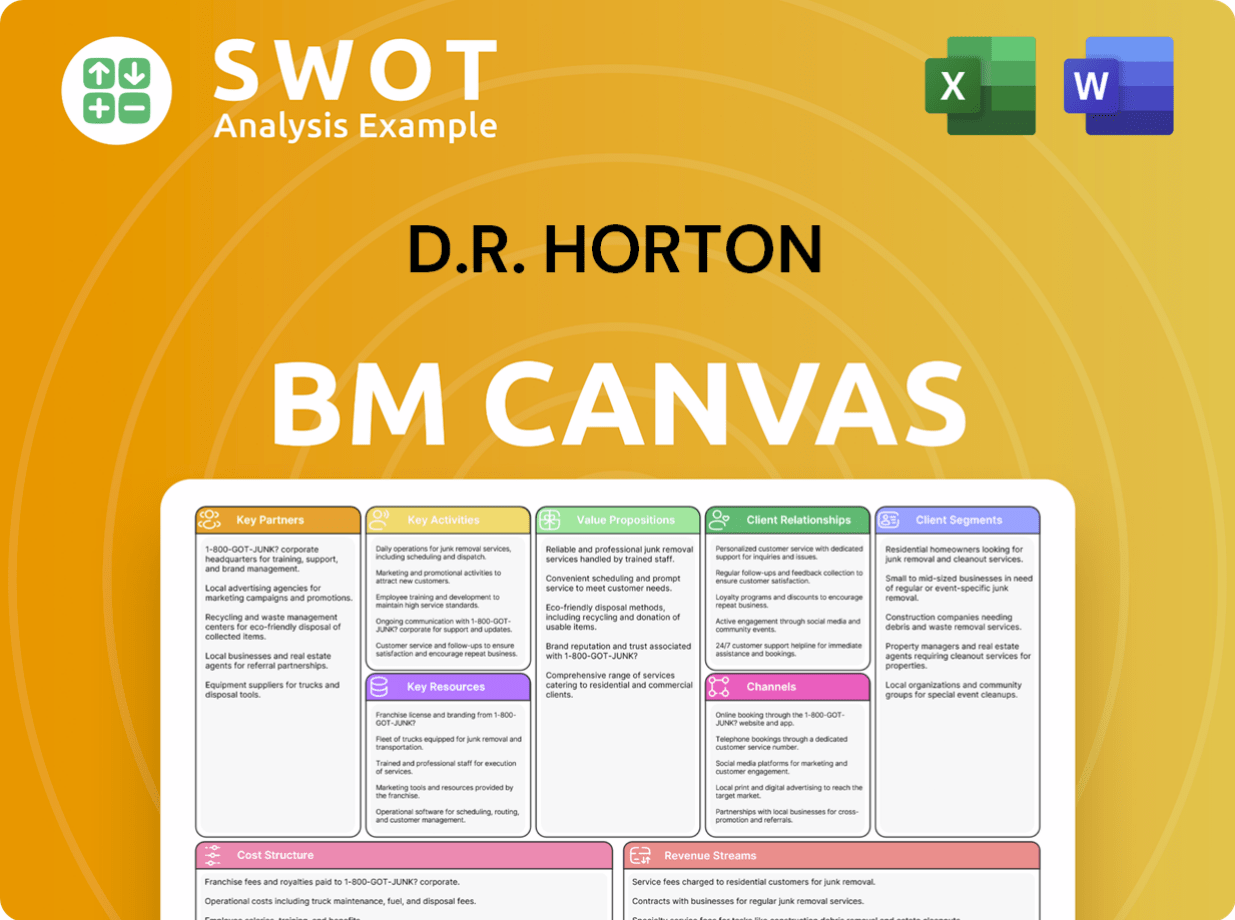D.R. Horton Bundle
How Did D.R. Horton Become America's Homebuilding Giant?
Ever wondered how a single home built in 1978 transformed into a national construction empire? D.R. Horton, a name synonymous with American homebuilding, boasts a fascinating history of strategic growth and market dominance. From its humble beginnings in Texas, the company has consistently reshaped the real estate landscape. Understanding the D.R. Horton SWOT Analysis can offer valuable insights into its journey.

This brief history of D.R. Horton delves into the key milestones that propelled the company from a local builder to the largest homebuilder in the United States. Discover how D.R. Horton, through smart acquisitions and a focus on affordability, navigated economic cycles and consumer demands. Explore the company's expansion history and the strategic decisions that solidified its position in the American homebuilding market.
What is the D.R. Horton Founding Story?
The story of D.R. Horton, Inc. begins in November 1978, in Fort Worth, Texas, with Donald R. Horton at the helm. His vision was to build homes that were accessible and customizable, a strategy that would quickly define the company's early success. This marked the beginning of what would become one of America's largest homebuilders.
Horton's journey started with a keen understanding of the market and a commitment to meeting customer needs. He saw an opportunity to offer flexibility in home design, a concept that set him apart. This approach, combined with a focus on building standardized homes, allowed for significant growth and expansion.
D.R. Horton was founded in 1978 by Donald R. Horton in Fort Worth, Texas. From the start, the company focused on building homes that catered to customer preferences, offering customization options within a standardized framework.
- The company's early success was fueled by its ability to adapt to buyer requests.
- Horton borrowed $500,000 to finance his first house.
- In 1979, the company built 20 houses, and by 1980, it had increased production to 80 houses.
- Donald R. Horton served as the founder, sole or principal stockholder, director, and president from 1978 to 1990.
Horton's strategy of offering customizable homes within a standardized framework proved successful. The company saw rapid expansion, essentially doubling in size each year throughout the 1980s. This growth was a testament to Horton's leadership and the company's ability to meet the evolving needs of homebuyers. For more information on the company's structure, you can read about the Owners & Shareholders of D.R. Horton.
D.R. Horton SWOT Analysis
- Complete SWOT Breakdown
- Fully Customizable
- Editable in Excel & Word
- Professional Formatting
- Investor-Ready Format

What Drove the Early Growth of D.R. Horton?
The early years of D.R. Horton, a prominent player in American homebuilding, were marked by rapid expansion and strategic moves. Founded in 1978, the company quickly grew, often doubling in size annually during the 1980s. This consistent growth in revenue and home construction laid the foundation for its future success. The company's strategic decisions played a crucial role in its trajectory.
In 1987, D.R. Horton began its expansion beyond the Dallas-Fort Worth market, signaling a broader ambition. This move was a significant step in establishing a wider presence across the United States. The company's strategic vision included geographical diversification, which helped to mitigate risks associated with regional economic fluctuations.
A pivotal moment came in June 1992 when D.R. Horton completed its initial public offering (IPO). The IPO raised $40 million by offering 6,900,000 shares of common stock at $12.00 per share. This influx of capital provided the financial resources for further expansion and strategic acquisitions. The IPO was a key step in the company's growth strategy.
The acquisition campaign started in earnest in 1994, with operations in 25 cities across 11 states. Between 1994 and 1999, D.R. Horton acquired 14 homebuilders. Notable acquisitions included Continental Homes in 1997 for $305 million and Cambridge Homes in 1998. These acquisitions expanded its operations beyond Texas into numerous markets across the United States, establishing a national presence.
Donald J. Tomnitz was promoted to vice chairman and chief executive, and Richard Beckwitt to president in 1998. D.R. Horton's growth was shaped by operational efficiency and its 'pace over price' principle. The company streamlined operations, particularly after creating a national accounts division in 1998. This strategic approach allowed D.R. Horton to gain market share.
D.R. Horton PESTLE Analysis
- Covers All 6 PESTLE Categories
- No Research Needed – Save Hours of Work
- Built by Experts, Trusted by Consultants
- Instant Download, Ready to Use
- 100% Editable, Fully Customizable

What are the key Milestones in D.R. Horton history?
The D.R. Horton history is a story of significant growth and strategic adaptation within the American homebuilding industry. The company has consistently demonstrated its ability to navigate market cycles and maintain its position as a leading real estate company.
| Year | Milestone |
|---|---|
| 2002 | Became the largest homebuilder by volume in the United States. |
| 2002 | Acquired Schuler Homes, expanding its presence in Western U.S. markets. |
| 2015 | Launched the Express Homes brand, targeting entry-level buyers. |
Innovation has been a continuous focus for the D.R. Horton company, with the introduction of various brands to cater to different market segments. This strategic approach includes offering diverse product lines and adjusting incentives to meet evolving consumer demands.
D.R. Horton has diversified its product offerings to include brands like Express Homes, Emerald Homes, and Freedom Homes. This caters to a broad spectrum of buyers, from first-time homebuyers to those seeking luxury or active adult communities.
The company focuses on affordability, introducing smaller floor plans and offering competitive incentives. In 2025, incentives included mortgage rate buy-downs in the range of 4.99% to 5.99% to support demand.
Despite its successes, D.R. Horton has faced challenges inherent in the homebuilding industry. These challenges include rising land costs, material inflation, and labor shortages, as well as market downturns and competitive pressures.
In the second fiscal quarter of 2025, D.R. Horton reported a 15% decrease in consolidated revenues to $7.7 billion and a 15% decrease in homes closed to 19,276 compared to the same quarter in fiscal 2024. Net income also decreased by 31% to $810.4 million in Q2 fiscal 2025 compared to Q2 fiscal 2024.
The company faces rising land costs, material inflation, and labor shortages. These factors impact construction timelines and profitability.
D.R. Horton operates in a competitive market, requiring continuous strategic adjustments. The company must adapt to changing consumer preferences and economic conditions.
In the second fiscal quarter of 2025, D.R. Horton repurchased 9.7 million shares for $1.3 billion and paid $125.5 million in cash dividends. This reflects the company's capital allocation strategy.
D.R. Horton Business Model Canvas
- Complete 9-Block Business Model Canvas
- Effortlessly Communicate Your Business Strategy
- Investor-Ready BMC Format
- 100% Editable and Customizable
- Clear and Structured Layout

What is the Timeline of Key Events for D.R. Horton?
The D.R. Horton company journey, a significant player in the American homebuilding sector, is marked by strategic growth and adaptation within the real estate company landscape.
| Year | Key Event |
|---|---|
| 1978 | Donald R. Horton founded D.R. Horton in Fort Worth, Texas, marking the beginning of the D.R. Horton history. |
| 1987 | D.R. Horton began expanding beyond the Dallas-Fort Worth market, signaling its early expansion history. |
| 1992 | The company completed its Initial Public Offering (IPO), becoming a publicly traded entity. |
| 1994 | D.R. Horton initiated an aggressive acquisition campaign, acquiring 14 homebuilders by 1999. |
| 1997 | D.R. Horton acquired Continental Homes for $305 million. |
| 1998 | Donald J. Tomnitz was promoted to CEO, and Richard Beckwitt became President. |
| 2002 | D.R. Horton acquired Schuler Homes, becoming the largest homebuilder by volume in the U.S., a position it has held since. |
| 2015 | The company introduced the Express Homes brand, focusing on entry-level buyers. |
| 2017 | D.R. Horton moved its headquarters from Fort Worth to Arlington, Texas. |
| 2024 | D.R. Horton closed over 93,000 homes, generating $36.8 billion in revenue and $4.76 billion in net income; Donald R. Horton, founder and chairman, passed away at age 74. |
| 2025 Q1 | The company reported $7.61 billion in revenue and $2.61 earnings per share, closing 19,059 homes. |
| 2025 Q2 | D.R. Horton reported $7.7 billion in consolidated revenues and $810.4 million in net income, closing 19,276 homes. |
D.R. Horton's updated fiscal 2025 guidance projects consolidated revenues between $33.3 billion and $34.8 billion. Homes closed by homebuilding operations are expected to range from 85,000 to 87,000. The company anticipates consolidated cash flow provided by operations to exceed $3.0 billion.
The company focuses on developing experienced teams and maintaining a strong liquidity position. It actively manages inventory investments across diverse markets to mitigate geographic risk. D.R. Horton plans to continue offering homes across a broad range of price points.
Analysts predict D.R. Horton will continue to gain market share, especially in the entry-level market. Revenue growth is projected at approximately 3%-4% annually through 2034. The company is positioned to capitalize on future growth opportunities despite market challenges.
D.R. Horton plans share repurchases of approximately $4.0 billion for fiscal 2025. The company is also evaluating potential acquisitions to enhance its operating platform. The focus remains on affordability and operational efficiency.
D.R. Horton Porter's Five Forces Analysis
- Covers All 5 Competitive Forces in Detail
- Structured for Consultants, Students, and Founders
- 100% Editable in Microsoft Word & Excel
- Instant Digital Download – Use Immediately
- Compatible with Mac & PC – Fully Unlocked

Related Blogs
- What is Competitive Landscape of D.R. Horton Company?
- What is Growth Strategy and Future Prospects of D.R. Horton Company?
- How Does D.R. Horton Company Work?
- What is Sales and Marketing Strategy of D.R. Horton Company?
- What is Brief History of D.R. Horton Company?
- Who Owns D.R. Horton Company?
- What is Customer Demographics and Target Market of D.R. Horton Company?
Disclaimer
All information, articles, and product details provided on this website are for general informational and educational purposes only. We do not claim any ownership over, nor do we intend to infringe upon, any trademarks, copyrights, logos, brand names, or other intellectual property mentioned or depicted on this site. Such intellectual property remains the property of its respective owners, and any references here are made solely for identification or informational purposes, without implying any affiliation, endorsement, or partnership.
We make no representations or warranties, express or implied, regarding the accuracy, completeness, or suitability of any content or products presented. Nothing on this website should be construed as legal, tax, investment, financial, medical, or other professional advice. In addition, no part of this site—including articles or product references—constitutes a solicitation, recommendation, endorsement, advertisement, or offer to buy or sell any securities, franchises, or other financial instruments, particularly in jurisdictions where such activity would be unlawful.
All content is of a general nature and may not address the specific circumstances of any individual or entity. It is not a substitute for professional advice or services. Any actions you take based on the information provided here are strictly at your own risk. You accept full responsibility for any decisions or outcomes arising from your use of this website and agree to release us from any liability in connection with your use of, or reliance upon, the content or products found herein.